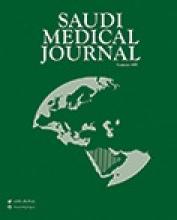Abstract
Objectives: To evaluate the use of hysteroscopy in the assessment of uterine pathologies in infertile women with repeated implantation failure (RIF) after in vitro fertilization (IVF) and determine whether removal of such pathologies increased pregnancy rates in women with RIF.
Methods: This prospective study was conducted at King Fahd Hospital of the University, Al-Khobar, Kingdom of Saudi Arabia, between January 2010 and December 2015. The inclusion criteria were women who underwent IVF treatment cycles and ended in more than 2 RIF, and women who underwent hysterosalpingography (HSG). Hysteroscopies were performed, findings were recorded, and the clinical pregnancy rates were compared and assessed in patients with and without uterine cavity abnormality. All hysteroscopic procedures were performed by a single consultant.
Results: Hysteroscopies were performed on 266 women who had at least 2 RIF. The average duration of infertility was 7.2±3.1 years. In 162 patients (60.9%), a hysteroscopy did not find any abnormality of the uterine cavity. In 104 patients (39.1%) there were one or more abnormal hysteroscopic findings. Hysterosalpingography was able to detect only 54 abnormalities (51.9%). The pregnancy rate was significantly higher in patients who were treated by a hysteroscopy for a detected uterine abnormality (39.4%).
Conclusion: A hysteroscopy was able to detect intrauterine pathologies which were missed by other investigative modalities. We believe patients with a history of RIF should undergo hysteroscopic examination before any further cycles are considered.
Footnotes
Disclosure. Authors have no conflict of interests, and the work was not supported or funded by any drug company.
- Received September 29, 2017.
- Accepted January 31, 2018.
- Copyright: © Saudi Medical Journal
This is an open-access article distributed under the terms of the Creative Commons Attribution-Noncommercial-Share Alike 3.0 Unported, which permits unrestricted use, distribution, and reproduction in any medium, provided the original work is properly cited.






